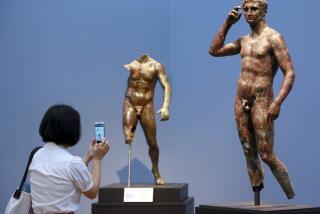J. Paul Getty Museum Sends 15 Artworks to Auction Block
- Share via
The J. Paul Getty Museum--a wealthy institution that often makes news by buying artworks no one else can afford--will sell 15 paintings from its collection in November at Sotheby’s London.
The auction is expected to total between $13 million and $18 million in sales, including a Paul Gauguin landscape valued at $6 million to $8 million. Six Getty works will be offered in a Nov. 21-22 sale of 19th-Century art; the remaining nine will go on the block on Nov. 28 in an Impressionist auction.
Why is the Getty selling? To refine its collection and buy more paintings.
“Most of the pictures were acquired by Mr. Getty for himself and haven’t been publicly exhibited in our galleries for some time. The funds from the sale will help us make important acquisitions for our growing collection--pictures that will be a delight to our visitors,” museum director John Walsh said, in a statement issued by press officer Lori Starr.
Although the paintings offered for sale are all 19th-Century and Impressionist works, the auction does not indicate a retreat from collecting art from that period, Starr said. “All the paintings (for sale) have been overshadowed by more recent acquisitions (from the same period),” she said, noting the museum’s purchases of James Ensor’s landmark work, “Entry of Christ into Brussels 1889”; a major landscape and a portrait by Pierre-Auguste Renoir, and a work by Paul Cezanne.
Oil tycoon J. Paul Getty, who died in 1976, bought most of the works to be auctioned in the ‘50s and ‘70s for his private collection, Starr said. They were displayed at his English home, Sutton Place in Surrey.
The auction’s most valuable piece, Gauguin’s “Breton Boy With a Goose,” was a later purchase--bought in 1983 by the museum. The 1889 Breton landscape is featured in the museum’s handbook, but Starr said it too is expendable in terms of plans for upgrading the collection.
Other Getty works in the Impressionist sale include Pierre Bonnard’s 1906 “Nude Standing Before a Screen” ($2 million to $3 million), Edgar Degas’ “Three Dancers in Rose” ($2 million to $3 million), Claude Monet’s “The Cliffs at Pourville, Morning, 1897” ($1.5 million to $2 million) and less expensive canvases by Gauguin, Degas, Maurice Utrillo and Loiseau Gustave.
Among pieces in the 19th-Century auction are those by John William Godward, John Calcott Horsley and Joaquin Sorolla y Bastida. Estimates range from $10,000 to $150,000.
The upcoming Getty auctions are a measure of a bullish art market. Prices have escalated so rapidly and precipitously that even the world’s most generously endowed museum must plot its acquisitions prudently. “The market shot up at a rate we didn’t predict,” Walsh said, in a recent interview. Though the Getty recently has made spectacular purchases--a $17-million Renoir and a $35.2-million Pontormo--the museum’s plans for its paintings collection have been curtailed as private collectors have paid vast sums at auction and the Getty has become “just one of many buyers,” Walsh said.
According to the Getty’s annual report, the museum and trust in 1988 spent $65.8 million on acquisitions for the museum’s collections and the trust’s libraries and archives. That is generous indeed by most museum standards, but these days a single painting can gobble up more than half the annual acquisitions budget for the museum and the trust combined.
Deaccessioning is sometimes a controversial matter, both ethically and aesthetically, but it is a standard procedure in American museums. Faced with rising prices and falling donations, more and more museums are examining their resources and putting less desirable parts of their collections up for sale.
This is not the first time the Getty has sold works from its collections. Another group was offered at auction in 1980, Starr said.
More to Read
The biggest entertainment stories
Get our big stories about Hollywood, film, television, music, arts, culture and more right in your inbox as soon as they publish.
You may occasionally receive promotional content from the Los Angeles Times.










